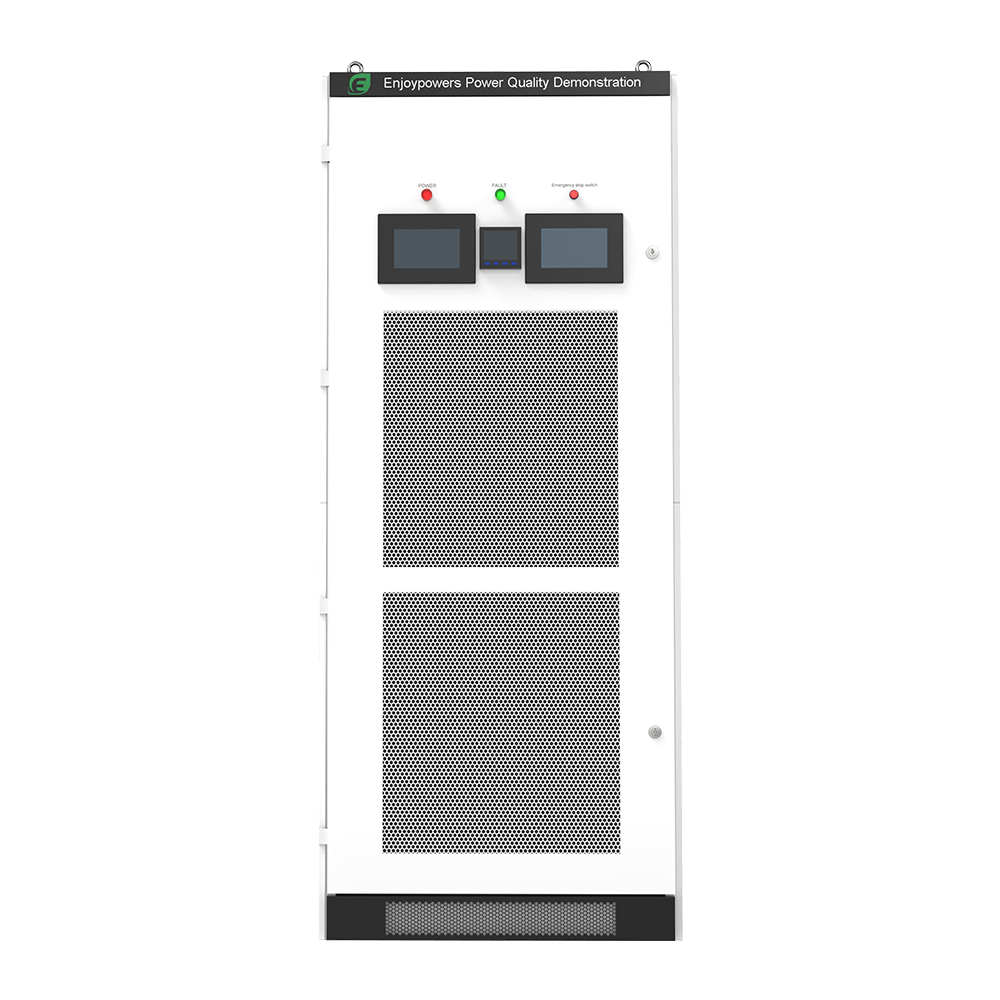Main Configuration of the Power quality demonstration cabinet
- 15kW Three-Phase Resistive Load: Can be step-controlled by phase to simulate three-phase unbalanced load scenarios.
- 2# SVG Module (20kVar): Used to generate inductive or capacitive reactive power.
- AHF Module (50A): Used to generate specific harmonic currents.
- Two 7-Inch HMIs: 1# HMI control SVGC, 2# HMI control harmonic and kVar generators.
- TSC-Type SVC: Includes thyristors, reactors, and capacitors (with one Delta and one Wye).
- Enjoypowers 1# SVG Module (35kVar): Used for harmonic compensation, power factor correction, and three-phase imbalance correction. It can also be integrated with the TSC-Type SVC to form a hybrid Var compensation system.
- Siemens Power Quality Meter: Used to detect key parameters such as power factor (PF), total harmonic distortion (THD), voltage, and current.
- Sine Series Cabinet: Designed with an IP20 rating, dimensions of 800×1000×2000mm, and a color of RAL7035.
System Block Diagram
Operating Steps for the Power Quality Demonstration Cabinet
- Powering On the System:
Use the Siemens Power Quality Meter and 1# 7-inch HMI to check various parameters under no-load conditions, including voltage, current, THDi, power factor, etc. Also, observe the voltage and current waveforms. - Three-Phase Imbalance Correction:
Gradually connect the resistive loads for the three phases. Use 1# 7-inch HMI to control the 1# SVG for three-phase imbalance correction. Observe the voltage and current waveforms and parameters caused by the unbalanced load, and understand the principles and effects of the correction. - Reactive Power Adjustment:
Use 2# 7-inch HMI to start the 2# SVG module to generate inductive or capacitive reactive power. Observe the parameters and waveforms for voltage, current, and power factor. Understand the relationship between active power, reactive power, apparent power, and power factor. During this process, adjust the size of the resistive load and observe the changes in waveforms and parameters. - Reactive Power Compensation:
Use 1# 7-inch HMI to control the TSC’s SVC and SVG for reactive power compensation, or create a hybrid compensation scheme. Observe the parameters and waveforms for voltage, current, and power factor. Understand the principles of power factor correction, and learn about the issues of under-compensation and over-compensation with TSC, as well as compensation accuracy and response speed. - Harmonic Generation:
Use 2# 7-inch HMI to start the AHF module to generate harmonics. Observe the parameters and waveforms for voltage, current, THDi, and power factor. Understand the calculation method of THDi. During this process, adjust the size of the resistive load and observe the changes in waveforms and parameters. - Harmonic Compensation:
Use 1# 7-inch HMI to control the 1# SVG for harmonic compensation. Understand the working principle of active harmonic filters. - Harmonic + Reactive Power Compensation:
Control the harmonic generator and reactive power generator outputs, and use 1# 7-inch HMI to control the 1# SVG for harmonic and reactive power compensation. Understand the effects of SVG on harmonic elimination and reactive power compensation, as well as its multiple operating modes. - Multiple Operating Modes:
Learn about the functions of SVG in harmonic elimination, reactive power compensation, and three-phase imbalance correction. Understand its multiple compensation functions, and how to set priority levels and capacity percentages.
Understanding the Functions and Operations of Enjoypowers Products
By operating the Sine Series Power Quality Demonstration Cabinet, you can gain comprehensive insights into the various functionalities of Enjoypowers’ AHF and SVG products, including:
- Multiple Operating Modes of SVG:
Harmonic Mitigation: SVG can effectively eliminate harmonics from the power system.
Reactive Power Compensation: SVG provides both inductive and capacitive reactive power compensation.
Three-Phase Imbalance Correction: SVG corrects imbalances in the three-phase power system.
Multiple Compensation Functions: SVG supports multiple compensation functions simultaneously. Users can set priorities and capacity percentages for different functions. Additionally, it allows setting deviation values based on the target power factor, providing more flexible and precise means of reactive power regulation. - Hybrid Compensation Scheme of SVG and SVC:
Combined Usage: The combination of SVG and SVC offers an enhanced compensation solution.
SVC Control: The SVC includes 16 built-in digital outputs (DO) that can directly control the switching of thyristors. - Harmonic and Reactive Power Generation by AHF and SVG:
AHF module: The AHF module generates specific harmonic currents for testing or demonstrating harmonics.
SVG module: The SVG module generates reactive power for testing or demonstrating power factor.
Through these operations and functional demonstrations, customers can comprehensively understand and master solutions to power quality problems. They will grasp the role of AHF and SVG in improving power quality, further enhancing their trust and confidence in using Enjoypowers products.
Application Scenarios of the Power Quality Demonstration Cabinet:
- Power Quality Education:
The demonstration cabinet serves as an educational tool to teach the principles of power quality, including issues such as harmonics, low power factor, and three-phase imbalance. It helps students and trainees understand how AHF (Active Harmonic Filter) and SVG (Static Var Generator) work and how they can be practically applied to solve power quality problems. - Power Quality System Demonstration:
The cabinet is used to demonstrate the functionalities and benefits of power quality solutions in a practical and interactive manner. It showcases how different modules, such as AHF and SVG, can improve power quality by mitigating harmonics, compensating reactive power, and correcting three-phase imbalances. This is particularly useful for potential customers and partners to visualize the performance and effectiveness of Enjoypowers’ products. - Testing System:
The demonstration cabinet acts as a testing platform for power quality solutions. It allows for the testing and verification of AHF and SVG modules under various load conditions and scenarios. This helps in ensuring the reliability, efficiency, and performance of the products before they are deployed in real-world applications.





